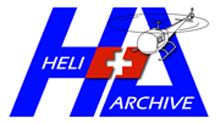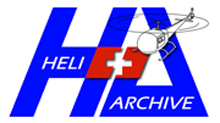Agusta-Bell 206A Jet Ranger - History and technical description
Some historical notes
The story of the Jet Ranger, one of the most popular helicopters is, to a certain extent, comparable to the famous literary fairy tale “The Ugly Duckling” written by Danish author Hans Christian Andersen.
The origin of this helicopter dates back to 1960 when the US Army asked American aircraft manufacturers to prepare design proposals for a small helicopter, that they wanted in mass quantity (3600 units!).
They wanted a light single-rotor, four place aircraft capable of carrying altogether a pilot, a fuel reserve for three hours and a payload of 180 kg (400 pounds) at a cruise speed of at least 204 km/h (110 knots).
Furthermore it had to be manufactured at a low cost, easily maintainable, reliable, with specified performance and a minimum time between overhaul of at least 1’200 hours.
The request of proposals also imposed that the engine to be used had to be the new turboshaft Allison T-63 (commonly known with the civil designation Allison series 250), which at that time was produced by the Allison Division of General Motors Corporation.
The US Army wanted to replace the light helicopters of the Bell OH-13 and Hiller OH-23 series, as well as the Cessna O-1 Bird Dog frequently used as “jeeps of the air”.
For reference only, it must be said that the Army’s LOH contest (LOH acronym for Light Observation Helicopter) was characterized by some striking surprises worthy of a spy story.
The new LOH had to basically perform observation, target acquisition, reconnaissance, convoy and command control tasks.
In early 1961, seventeen proposals from twelve manufacturers (Bell, Boeing, Cessna, Gyrodyne, Hiller, Hughes, Kaiser, Kaman, Lockheed, Mc Donnell, Republic, Sikorsky) were submitted.
After a first selection, three proposals were positively judged by the examiners.
The three finalists were the Bell Helicopter Company, with the project designated D-250, the Hiller Aircraft, with its Model 1100, and finally the Hughes Tool Company, with the Hughes 369 project which was only later re-admitted.
On May 19, 1961, the Bell Helicopter Company (purchased on July 2, 1960 by Textron Inc. in Providence /Rhode Island, a conglomerate founded by the magnate of the textile industry Royal Little), signed a 5.8 million US dollars contract for the development and the construction of five prototypes.
The US Army initially named them YHO-4 and then, when a new classification system was introduced, OH-4A.
To develop the new LOH helicopter, Bell appointed a special group of technicians.
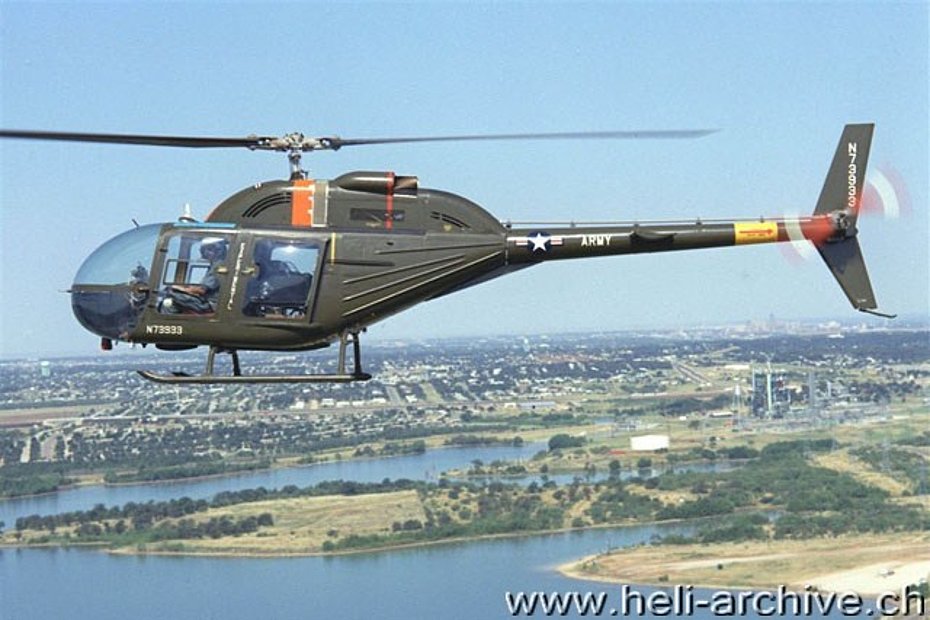
The first prototype (s/n 62-4202 much later registered N73999) began its test flights on December 8, 1962, less than 13 months after the contract was signed and 2 months ahead of the scheduled date.
On January 23, 1964, the company presented the OH-4A to the Army with a ceremony at Bell’s factory in Fort Worth.
On April 28, the Federal Aviation Administration issued Bell a Type Certificate for the OH-4A, another condition fixed by the military in the contract.
Flight tests were concluded by military pilots until June 30, 1964.
In March 1965 the US Army announced that the winner (as many had already presumed) was the Hughes OH-6A.
The Bell Company, like Fairchild-Hiller (Hiller was absorbed by Fairchild in September 1964), decided to make a version of the OH-4A for civil use, despite the fact that they were completely engaged with the production and development of other models.
The flight performances were in fact good. An insider joked that the OH-4A lost the competition because it was as ugly as sin!
Initially a team of engineers simply tried to enlarge the cabin using blister doors and windows.
However this wasn’t the answer to help improve the helicopter, so they decided to entrust two external companies with the task of finding a solution to the problem.
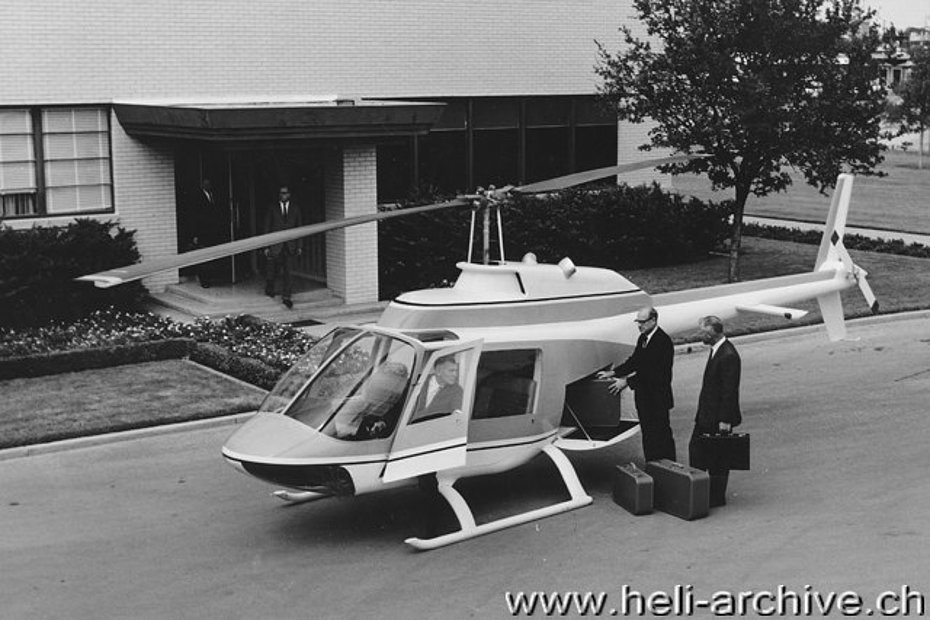
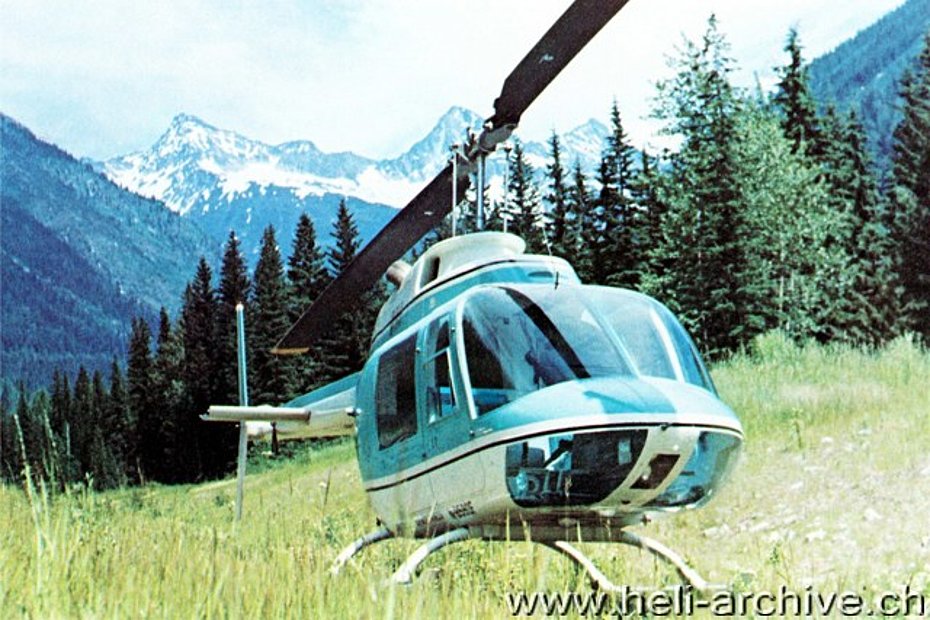
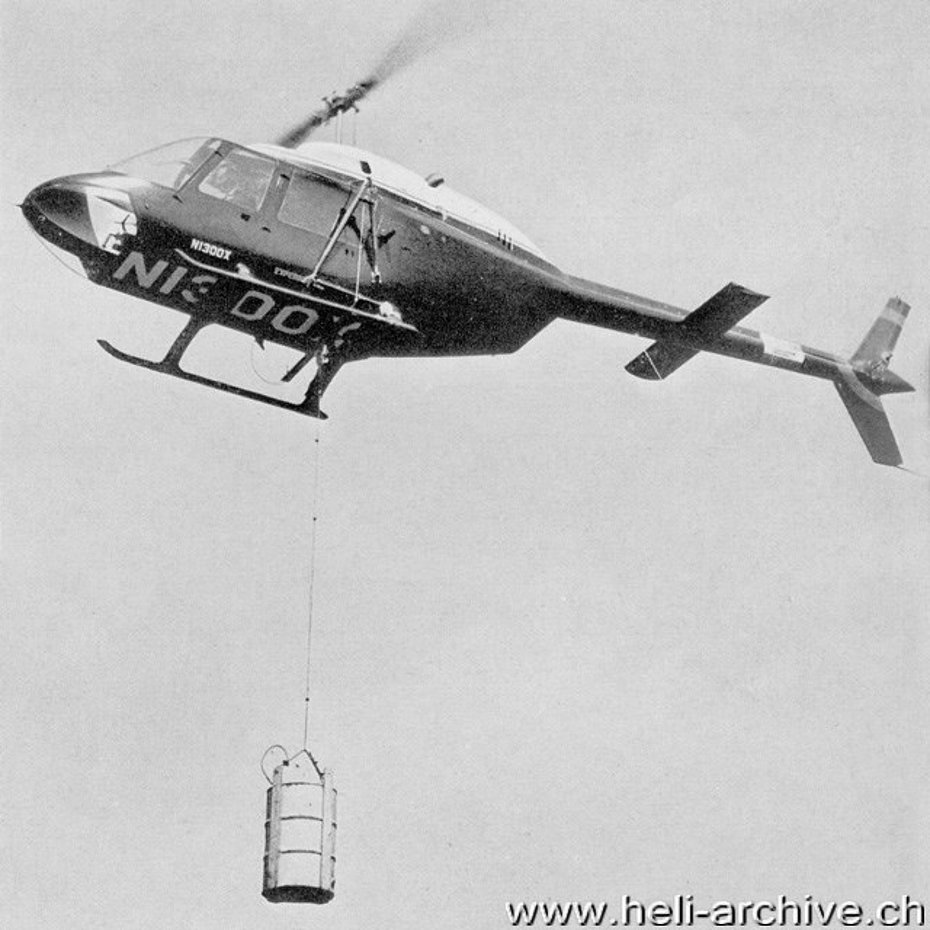
The 206 changes its look
The Jet Ranger’s looks were designed by Charles Wilfred Butler, an American industrial designer who also worked on the interiors of the Concorde. Butler’s firm completely redesigned the Bell OH-4A. With his team he restyled the machine inside out with a technique already used in the automotive world, creating one of the world’s most successful helicopters.
The development cost and the construction of the mock-up, were initially secretly managed.
Then the truth came out, but the result was so good that Bell’s managers decided to launch the production of the Model 206.
Edwin J. Ducayet, who was Bell’s president, named it Jet Ranger because it was the turbine powered heir of the popular 47J Ranger.
The alterations were quite radical and not limited to the external look. For example, the original stabilizer bar (until that moment a characteristic of all the Bell productions) was removed and the rotor system simplified.
The construction of the first prototype (s/n 1 reg. N8560F) started in July 1965 and was completed some months later.
On October 12, the Jet Ranger’s mock-up was officially presented at the National Business Aircraft Association meeting. At the same time Bell started to accept orders for the new aircraft.
The prototype officially made its first flight on January 10, 1966, shortly before the 18th Helicopter Association of America (HAA) convention (Arlington/Texas 23-26 January 1966).
In the following months two other prototypes (s/n 2 N8590F and s/n 3 N1300X) were built and flight tested.
On October 20, 1966 the Bell 206A Jet Ranger obtained the FAA Type Certificate.
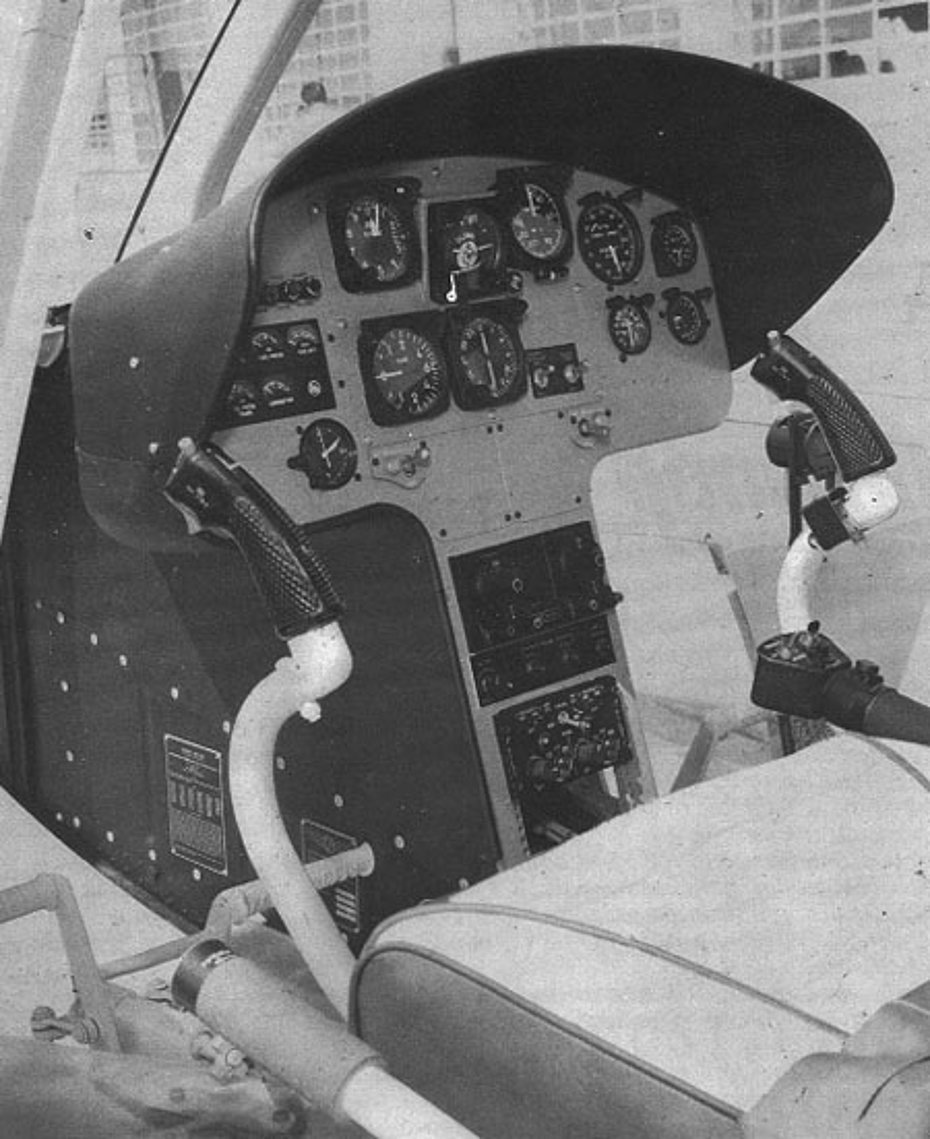
The first deliveries took place on January 13, 1967. Harry Holly, president of the Hollymatic Corporation in Park Forest (Illinois), purchased N1368X (s/n 7) while the second (s/n 8) with call sign N1369X was sold to Van Nuys based National Helicopter Service & Engineering Company. The sixth Jet Ranger production (reg. E76227) was sent to Italy where Agusta used it as a flight demonstrator. At the same time, the Italian firm started to manufacture the Jet Ranger under Bell’s license.
The initial price of the Jet Ranger was 89’500 US $ (1967), corresponding to about 420'000 Sfr.
The aircraft had an immediate commercial success, in fact about a hundred were sold in less than 9 months.
The Jet Ranger’s revenge
Within a few years, after a series of problems connected with the delivery of the Hughes OH-6A, the US Army decided to re-open the LOH competition.
On March 8, 1968 the Jet Ranger took revenge by being selected as the new LOH winner. The Texan company, on the basis of a multi-year procurement programme received an order (value 123 million dollars) to manufacturer 2’200 aircrafts. The helicopter received the military designation OH-58 Kiowa, in honor of the homonym tribe of American Indians. The first deliveries began in 1969.
The Jet Ranger started a brilliant career and remained in production until December 2010.
The last Bell 206B JetRanger helicopter (s/n 4690), manufactured at Bell Helicopter plant in Mirabel (Quebec/Canada), was delivered in December 2010 to a Canadian customer, Russ Cmolik, with a short delivery ceremony.
According to up-to-date information, a total of about 8’400 Jet Rangers were produced. Altogether these aircraft have flown over 37 millions flying hours.
One of the first Jet Ranger to be delivered has logged 38’000 hours of flight, almost a record for this category of aircraft.
The Agusta’s production
In the Autumn of 1965 Bell signed a deal with Agusta, giving them the license to manufacture the Jet Ranger.
The first official exhibition in Italy of this helicopter took place in Miland and Rome, between October 31, and November 10, 1966. The helicopter (probably sent to Italy expressly for a demonstration) was piloted by the famous pilot Joe Mashmann.
With this helicopter, Agusta had a great commercial success. It remained in production between 1967 and 1996, and nowadays with 956 units, it is on the top of most produced models by the Italian group.
Technical description
The Agusta-Bell 206A Jet Ranger is a light five place helicopter of standard configuration.
The main rotor is a semi-rigid seesaw type with two main rotor blades which have a base section chord of 33.68 cm. The blades are of all metal construction and are individually interchangeable.
The tail rotor is a semi-rigid seesaw type. The two interchangeable rotor blades are all metal assemblies consisting of a stainless steel shell reinforced by a honeycomb filler and stainless steel leading edge abrasive strip.
The main rotor turns at 394 rpm while the tail rotor turns at 2'550 rpm.
To ease pilot workload and fatigue the helicopter is fitted with boosted flight controls (cyclic and collective).
The main transmission is mounted forward of the engine, on the cabin roof deck. It is supported by and isolated from the helicopter by mean of two pylon support links and a drag link that is secured to the bottom of the transmission. It is coupled to the turboshaft by means of a short drive shaft.
The transmission provides a total reduction of 6’016 rpm (turbine) to 395 rpm (main rotor).
Airframe
The fuselage consists of three main sections. The forward section extends from the cabin nose to the bulkhead aft of the passenger compartment, the intermediate section which extends from the bulkhead aft of the passenger compartment to the tailboom, and the tail boom.
The forward section utilizes aluminium honeycomb structure and provides for pilot and passenger seating, fuel cell enclosure, and pylon support.
The forward section is separated from the intermediate section by mean of a honeycomb bulkhead.
The intermediate section utilizes an aluminium semimonocoque construction and encloses a deck for engine installation, a compartment under the engine for heater and electrical equipment and the baggage compartment.
The engine is horizontally mounted aft of the transmission and above the fuselage to simplify the drive system, improve the insle/exhaust arrangement, reduce cabin noise and to provide better structural intregrity. It is supported by three A mounts on the service deck and is coupled to the main transmission through the freewheeling unit and main drive shaft. A titanium engine pan, located below the engine area, acts as both a drip pan and firewall. It is curved to provide sufficient clearance to allow for the removal of accessories without having to remove the engine. The engine pan along with the titanium fore and aft firewalls are fitted within the top part of this section for form the engine compartment.
The transmission is protected with a one-piece fiberglass cowling, while the engine and oil cooler are protected with honeycomb fiberglass cowlings.
Cowlings are hinged for full access to transmission, boost package and engine inspections.
The aluminium tailboom, except for the forward 254mm where the loads are redistributed by means of four intercostals load carring members, is a full monocoque structure.
It supports the tail rotor drive shafts, tail rotor, gear box, vertical fin, the horizontal stabilizer (with highly cambered inverted aerofoil section), tail rotor drive shaft bearing supports, and the internal supports for the tail rotor control tubes. The tail rotor is protected from ground strikes by a small tail skid.
The landing gear system consists of two main skid tubes and two curved tubular cross tubes. It is attached to the fuselage structure by means of four strap assemblies and can be removed and installed with ease. Provisions for installing ground handling wheels and two rings are made on the skid tubes.
A tubular steel tail skid and bumper are installed on the lower portion of the vertical fin with the purpose to warn the pilot of a tail low altitude when landing.
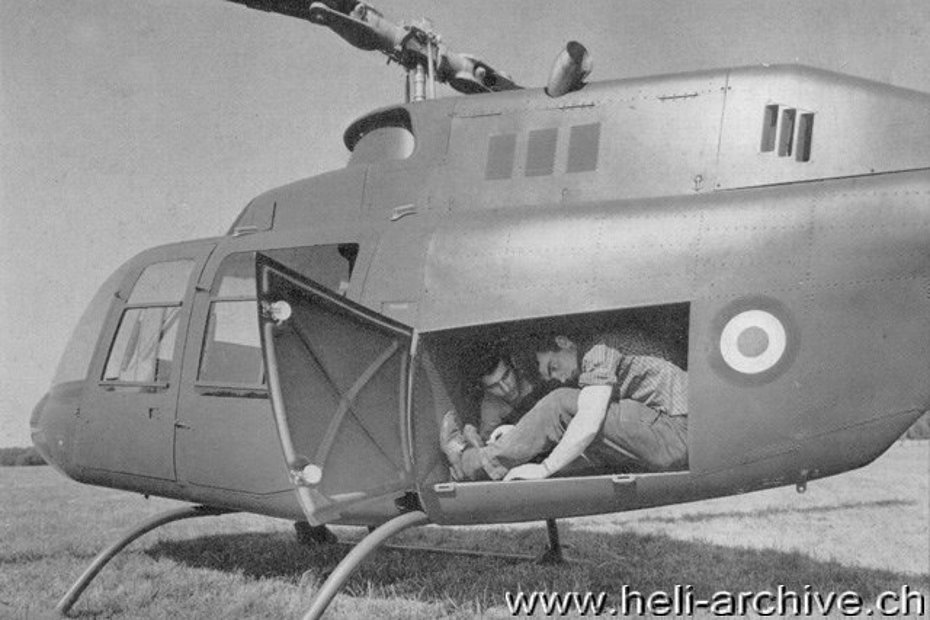
The cabin
Pilot and co-pilot (or front passenger) enter the cabin trough the two front doors, while passengers who seat side-by-side use the larger rear doors.
The doors are made of formed aluminium sheet and Plexiglas.
External view from the front seat (the pilot seat is on the right) is very good. Pilot and co-pilot seat were designed to absorb 25 g impact loads.
Front and rear seat are separated by a rugged structural turnover bulkhead which provides an added margin of structural integrity to protect cabin occupants.
The instrument panel is mounted on a central pedestal in front of the two crew seats. The pedestal extends from the instrument panel downward and between the seats to form a console for radios and miscellaneous controls.
The overhead console is centrally positioned just aft of the windshield on the ceiling and contains all the circuit breakers and most of the electrical switches.
The passenger’s cabin has a volume of 1.13 mc and was designed to offer maximum comfort. The three passengers seat side-by-side.
On the left side of the tail boom there is a 0.45 mc baggage compartment where it is possible, in compliance with the weight and balance diagram, to load up to 114 kg.
Behind the passengers there is another a small compartment (designed as overhead lock) where it is possible to put back small objects (such for example the headsets), and then a second honeycomb bulkhead.
A honeycomb box structure protects the single bladder type 288 litres capacity fuel cell which is located below and behind passenger seat. The refueling point is on the starboard side of the fuselage, beneath the aft passenger seats.
The battery is located in the nose, where there is too the external power receptacle which is immediately above the landing light position.
The helicopter is equipped with a 28V direct current electrical system. Power is obtained from a nickel-cadmium, vented, 24V, 17Ah battery and a 30V 150 Ah (derated to 105 Ah) combination started/generator.
The skid landing gear (high or tall on customer request) is made with aluminium tubes bolted to round extruded crosstubes.
The turboshaft
The Agusta-Bell 206A Jet Ranger was delivered with a 236/317 kW/shp take-off power and a 201/270 kW/shp max continuous power Allison 250-C18 turboshaft.
This compact and light power plant (weight about 64 kg) is a derivative of the T-63-A-5 originally sponsored jointly by the US Army and USAF from June 1958 onwards as the T63 for the new LOH.
The successive and more powerful version (military known as the T63-A5A) got the FAA certification in September 1965 with the designation 250 C-18.
The average fuel consumption of this turboshaft is about 80 litres/h.
Performances
In ISA conditions, at 1’360 kg take-off weight, the helicopter has a cruising speed of about 180 km/h, while the never exceed speed at sea level is 241 km/h (130 knots). Its absolute service ceiling is 6'100 meters.
In the same conditions the helicopter hovers in ground effect at about 2’770 meters, or 1'020 meters out of ground effect. The initial rate of climb at sea level is about 440 m/min.
Its range is about 630 km corresponding to 3h30min of flight endurance.
Dimensions, weights and payload
The main rotor of the Agusta-Bell 206A Jet Ranger has a diameter of 10.16 m (disc rotor area 81.1 m2), while its tail rotor has a diameter of 1.57 m (rotor disc area 2.14 m2. The fuselage has a length of 8.74 m. The height measured on the top of the rotor mast is 2.91 m (with low skids).
The aircraft standard empty weight is about 725 kg, while its MTOW is 1’360 kg with internal load, or 1’520 kg with external load.
Allowing for a standard pilot weight (77 kg) and with a fuel and oil reserve for one hour of flight (about 64 kg) the helicopter has a payload of about 495 kg.
It can carry four passengers with their baggage or up to 400 kg suspended on its barycentric hook.
Optional equipment
The versatility was further extended by the availability of a wide range of accessories such as: stability and control augmentation system, rotor brake, dual controls, night flying kit, internal cargo platform, cargo sling (trapeze), fixed cargo hook, electric hoist, float landing gear, emergency pop-out float, snow skids, fire extinguisher (cabin), heater, first aid kit, shoulder harness for pilot and co-pilot, engine hour meter, fire detection system, fire extinguisher system, custom deluxe cabin interior.
Civil employ
The Agusta-Bell 206A Jet Ranger has found a wide range of application among the civil defence, firemen and police corps. At the beginning it was also frequently used as an aerial ambulance.
Nowadays it is usually used by the commercial companies for passenger or cargo transportation, school, pleasure flying, road traffic control, aerial photography and aerial film, firefighting. It is an excellent training helicopter, and is commonly the first turbine machine which piston helicopter pilots convert on to.
Its multi-role character makes it suited for almost every kind of transportation. Despite the long period elapsed from its first flight it is still extensively used worldwide.
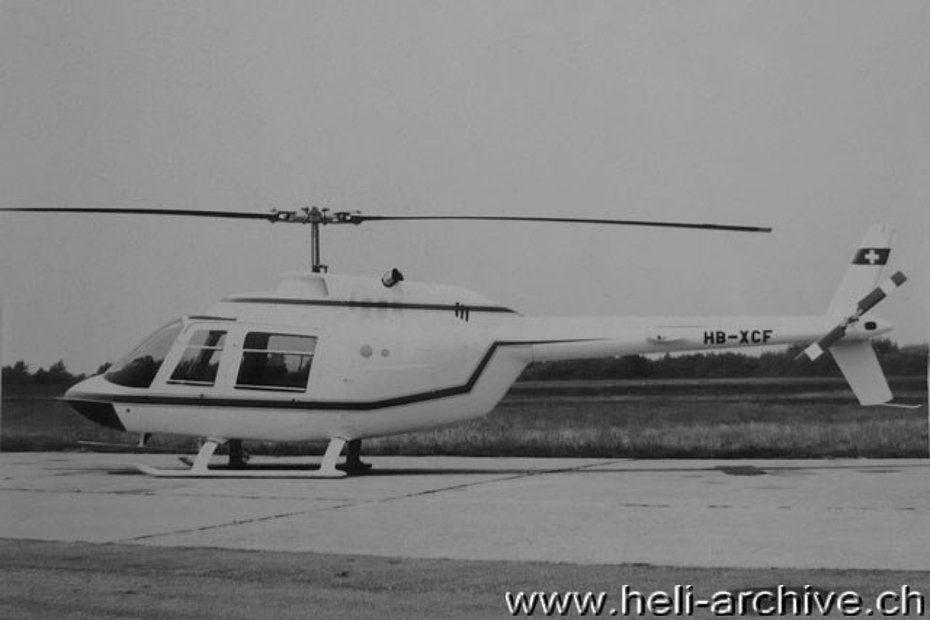
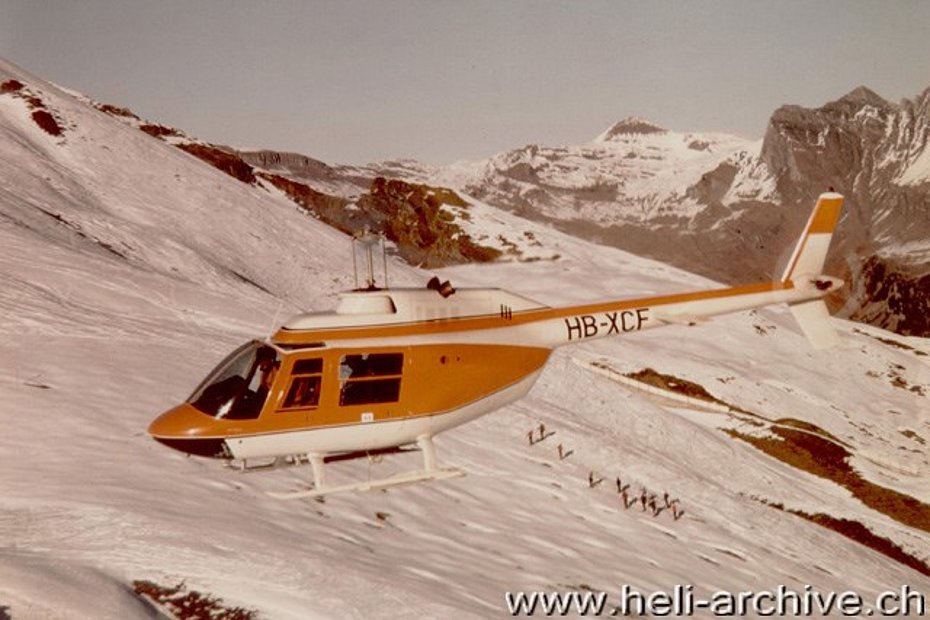
HB-XCF - The first Jet Ranger in Switzerland
The Jet Ranger was probably presented for the first time in Switzerland in June 1967.
A few months earlier, the Italian company Agusta had started manufacturing the new helicopter under Bell license while at the same time conducting a series of promotional tours to boost the sales. It is during one of those tours that the helicopter was presented at the airport of Belp/BE.
As happened with the 47 and the 204 series, Agusta experienced a great commercial success and eventually sold 956 units. It remained in production at Cascina Costa facility from 1967 until 1996.
The first customer to purchase the new aircraft was the Aztec SA, a Greek company which had a branch office in Lausanne. This society belonged to the Greek shipowner Stravros Livanos who usually used (among others) the amphibian aeroplane Piaggio P-136L-2 HB-EMG for his private and business travels.
When the latter was damaged it was replaced with the brand new Agusta-Bell 206A Jet Ranger (s/n 8013 b/y 1967) HB-XCF which was inspected by FOCA technicians at Belp on July 18, 1967. At that time the helicopter had not yet been certified by Registro Aeronautico Italiano (RAI). That is why the aircraft flew for some months with a provisional certificate of airworthiness.
The Jet Ranger in fact obtained the type certificate n° A-140 from Registro Aeronautico Italiano (RAI) on August 8, 1967.
Initially HB-XCF was based in Athens where it was flown by the Greek Col. rtd George Pantelidis.
The aircraft then came back to Switzerland and was based at Belp. There it was repainted with a new white/orange colour scheme.
During that period the aircraft had its celebrity moment too, featuring in the sixth spy film of the James Bond series On Her Majesty's Secret Service.
In this film the helicopter (piloted by the Austrian pilot Wolfgang Weinlechner) transports James Bond (played by the Australian model George Lazemby) atop the Schilthorn (2,970 m) where Blofeld head of the SPECTRE (played by Telly Savalas) had established a clinical research institute.
In reality the latter construction is the famous revolving restaurant Piz Gloria which was then still under construction.
HB-XCF was subsequently purchased by Heliswiss which put it in service by April 1969. The helicopter was intensively used in Switzerland and abroad for passenger and freight transportation.
During the January 1973 overhaul it was converted into a 206B Jet Ranger II. The original turboshaft was replaced with a more powerful 298/400 kW/cv Allison 250 C-20.
On April 4, 1973 it was seriously damaged when its rotor blades struck terrain during an alpine flight.
The helicopter was repaired and flew again until September 22, 1977. While engaged in a series of spray flights for the FAO organisation in the Beni-Slimane area (Algeria) the pilot was forced to land following a sudden loss of engine power. Fortunately he was not injured but the helicopter landed so heavily that it was damaged beyond repair.
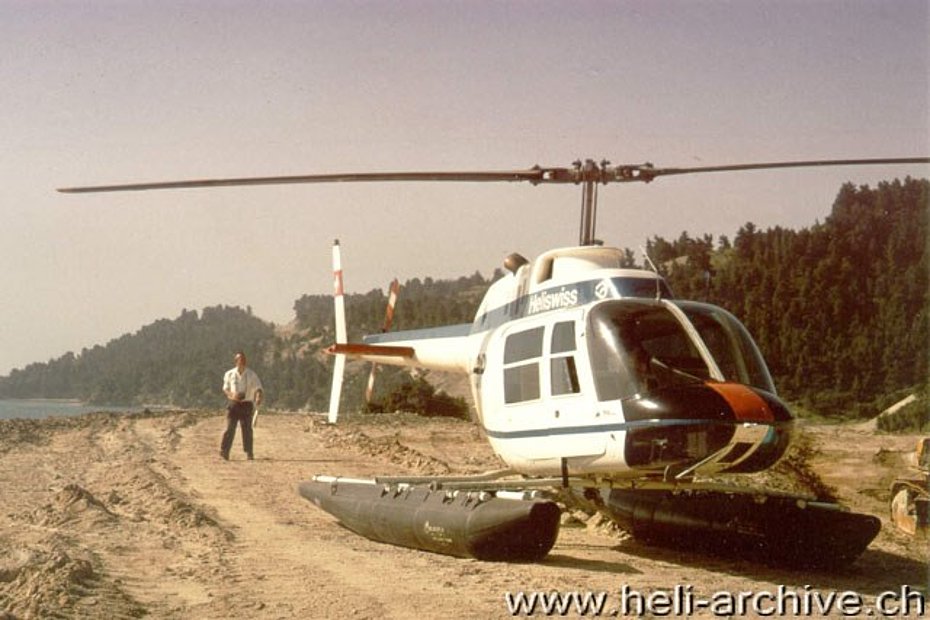
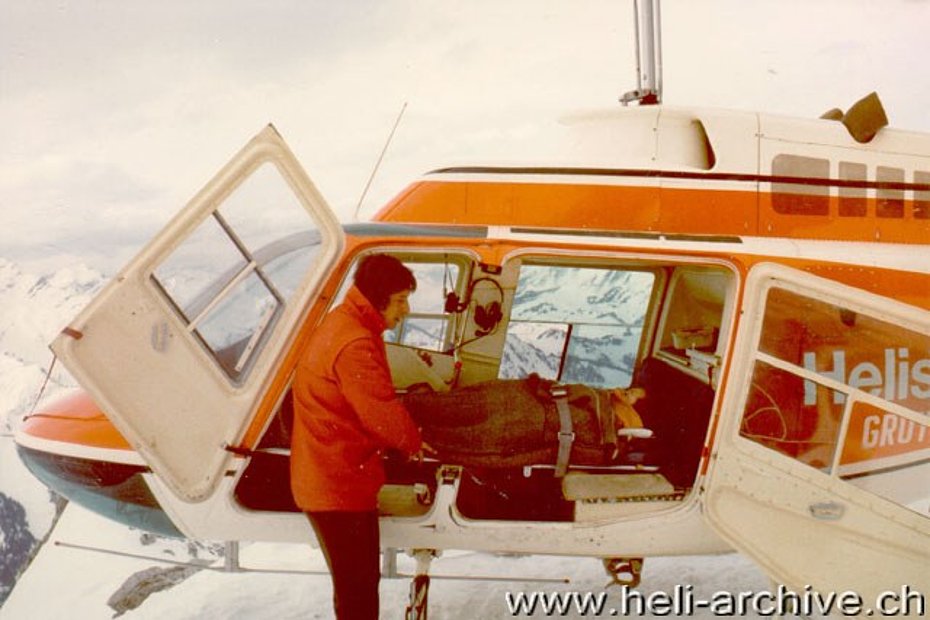
A Jet Ranger for Air Zermatt
The second Jet Ranger to be registered in Switzerland was HB-XCL (s/n 8028 b/y 1968), Air Zermatt’s first helicopter.
This aircraft started its flying activity in the famous Valaisan resort in April 1968 piloted by Günther Amann. It was mainly used for passenger and freight transportation as well as search and rescue flights.
However the service period of this helicopter was short lived when on March 12, 1969 it rolled over on the Theodul glacier (3,340 m) during a mountain landing characterized by adverse weather conditions.
HB-XCP s/n 33 b/y 1967 ex N7833S (manufactured by Bell) was Heliswiss' first Jet Ranger and was put in service on August 6, 1968.
The Belp based company purchased this aircraft from John Von Neumann who registered it in Switzerland a few months earlier.
Among the first Swiss Jet Ranger operators there was the Swiss Air Rescue Guard which purchased HB-XCU (Agusta s/n 8098 b/y 1968) in Autumn 1968.
The helicopter was used in the central-east region of Switzerland until 1972 when it was replaced by the larger and more powerful Alouette III.
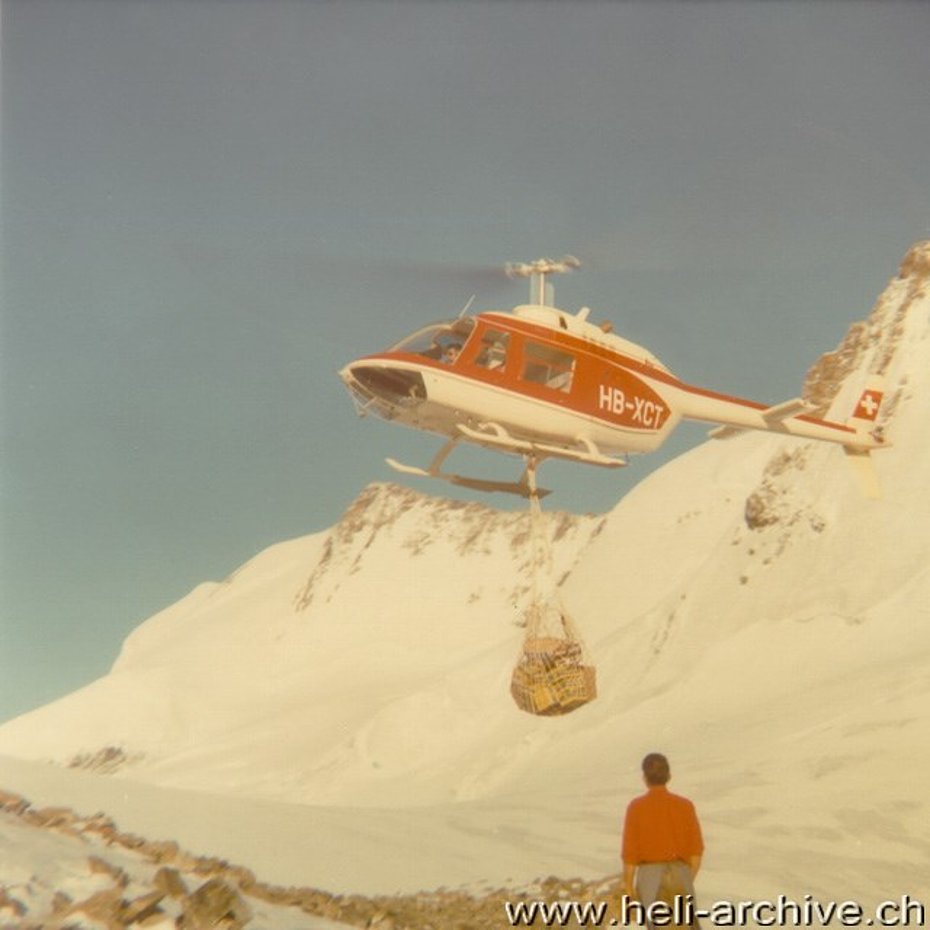
The pilots enthusiastically greeted the new helicopter, even if the limited power reserve of the Allison 250 C-18 caused some problems.
Rudolf Renggli, Heliswiss' ex chief-mechanic who is now retired, recalls that "The non-respect of the limits by (unskilled) pilots, who often were called to transport building materials at high altitudes, caused damages. In fact on several occasions, expensive reparations had to be done on the turbines, which showed evident signs of overheating on the blades”.
Renggli also says that "with an increasing in-service experience, the manufacturer issued technical service bulletins in order to improve the original design. These improvements (normally involving some modifications) for example resulted in either lower maintenance or increased performance, but evidently also resulted in extra costs. Year after year these technical service bulletins filled several ring binders".
